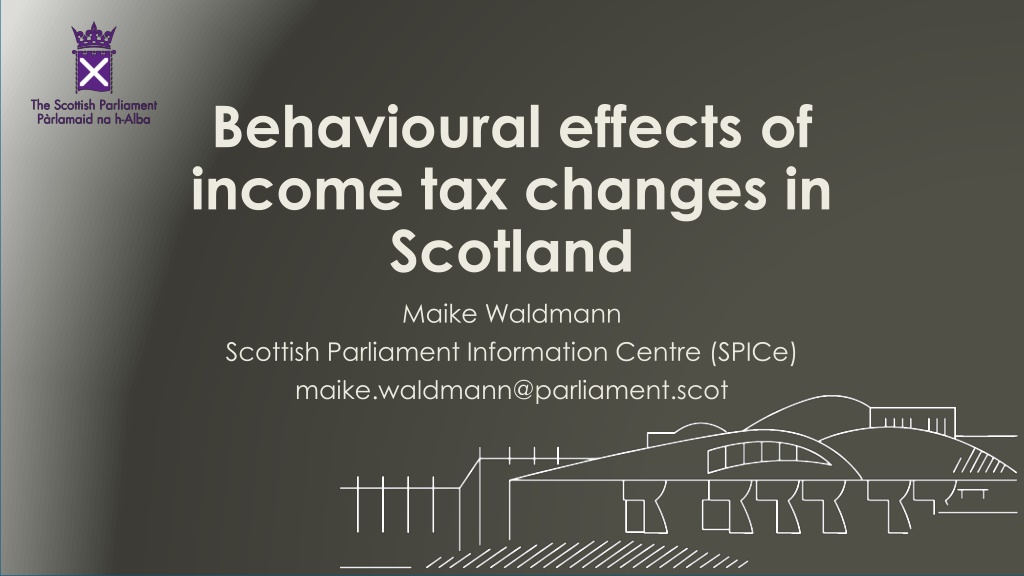
Understanding Behavioral Effects of Income Tax Changes in Scotland
Explore the impact of income tax changes in Scotland through behavioral analysis and comparisons with forecasted revenues. Learn how SPICe uses UKMOD models and collaborates with other teams to ensure accurate results.
Download Presentation

Please find below an Image/Link to download the presentation.
The content on the website is provided AS IS for your information and personal use only. It may not be sold, licensed, or shared on other websites without obtaining consent from the author. Download presentation by click this link. If you encounter any issues during the download, it is possible that the publisher has removed the file from their server.
E N D
Presentation Transcript
Behavioural effects of income tax changes in Scotland Maike Waldmann Scottish Parliament Information Centre (SPICe) maike.waldmann@parliament.scot
Behavioural analysis in SPICe How we use the UKMOD behavioural add-on How we know the results are right How we talk about them
Scottish rates of income tax Baseline* Scottish Budget bill Dec 2023 proposal (now implemented) 19% Starter 12,571 14,876 Basic 14,877 26,561 20% Intermediate 26,562 43,662 21% Higher 43,663 125,140 42% Higher 43,663 75,000 42% Advanced 75,001 125,140 45% Top 125,141+ 47% Top 125,141 + 48% *SFC baseline; bands uprated from previous year
UKMOD DEF: Constants Baseline Full proposal Advanced band Top rate +1p
UKMOD TAX: Personal income tax Baseline Full proposal Advanced band Top rate +1p
UKMOD Statistics Presenter output (Reform = full proposal, as implemented)
How we know results are right All models are wrong Compare with others models of the same proposal (but note that we all tend to use the same assumptions) Compare with SG ready reckoners Regular catch-ups with other modelling teams in Scotland to discuss general methodology issues
Comparison with SFC forecast Expected additional income tax revenue in 2024-25 as forecast by SFC and SPICe Static and post-behavioural effects Note: SPICe estimates on this slide are unrounded to show the comparison. We would round any estimates prior to using them in any other way. SFC forecasts: Scotland s Economic and Fiscal Forecasts December 2023 | Scottish Fiscal Commission; SPICe estimates calibrated to SFC baseline
Comparison with SG ready reckoners Post-behavioural impact of small changes to income tax, in million Scenario name Increase Starter rate by 1p Increase Basic rate by 1p Increase Intermediate rate by 1p Increase Higher rate by 1p Increase Advanced rate by 1p Increase Top rate by 1p Decrease Top rate by 1p SG 65 239 172 80 21 UKMOD HBAI 61 239 175 81 Note: SPICe estimates on this slide are unrounded to show the comparison. We would round any estimates prior to using them in any other way. 9 -1 -2 6 -8 Increase the Starter rate band by 100 Reduce the Starter rate band by 100 Increase the Basic rate band by 1,000 Reduce the Basic rate band by 1,000 Increase the Higher rate threshold by 1,000 Reduce the Higher rate threshold by 1,000 Increase the Advanced rate threshold by 1,000 Decrease the Advanced rate threshold by 1,000 -3 3 -2 3 -15 16 -114 129 -15 16 -125 133 -3 3 -3 3 Scottish tax ready reckoners: direct effects of illustrative tax changes for 2024 to 2025 - gov.scot (www.gov.scot); SPICe estimates not calibrated
How we talk about it Lately, we have used behavioural analysis mainly when responding to MSP enquiries, and not so much in published outputs (blogs & briefings) Estimates of behavioural effects are less certain than static effects and sensitive to underlying assumptions -> SPICe blog on behavioural effects and sensitivity to TIEs Estimates are calibrated to SFC forecasts Standard wording Rigorous rounding
Thank you Maike.Waldmann@parliament.scot
